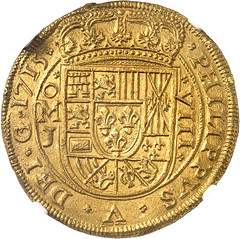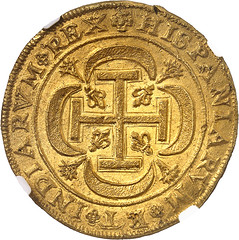
PREV ARTICLE
NEXT ARTICLE
FULL ISSUE
PREV FULL ISSUE
V25 2022 INDEX E-SYLUM ARCHIVE 1715 FLEET SPANISH PHILIPPE V ROYAL 8 ESCUDOSA rare "Royal" 8 escudos from the 1715 Fleet is offered in the June 3-4 MDC Monaco auction. Here's a standalone article I excerpted from the press release. A great item. See the earlier article for more information on the sale. -Editor
Lot 1110.
Obv. *PHILIPPVS* V* DEI* G* (date)*. Crowned arms of Castilla and Leon, Catalonia, Aragon, Sicilia, Austria, Burgundy, Brabant, Flanders, Tyrol and Bourbon, surrounded by *(mint) (assayer) and *VIII* Rev. *HISPANIARVM* INDIARVM* REX. Cross potent, lilies in each angle pointing to the center, in a quatrefoil surrounded by four tulips. Aureo 2196 – Cal.291 – Cayon.9950 – Onza.401 – KM.R57.3 – Fr.7 ; Gold – 27 g – 35 mm – 12h. This is the second highest graded by NGC, the first one graded MS66 and this one MS62, coming from a Spanish silver fleet's wreck of 1715. NGC MS62 (Shipwreck certification). Big rosettes' variety on the reverse. Letter J for José Eustaquio de Leòn, assayer. Very rare, with only 5 known examples and for a recently discovered date. Assay's traces on the edge with minor marine corrosion on the surface (certified by NGC, coming from 1715 Fleet shipwreck). However, reliefs are specially processed in the die, giving a satin effect to this example, almost in mint state, never having circulated. Uncirculated. Price: 250000 €
This coin is a
The few
On the 31st july 1715, the ships encounter a
hurricane killing 1500 officers and sailors whereas the shipment is scattered. Survivors inform authorities and a rescue
mission is launched to help the shipwrecked and get the treasure back. For months, Spain recovers artefacts and millions
of coins, even if pirates harass the operation. In 1718, the rescue mission is ended, considered as a success, even if lots
of artefacts and coins are left undiscovered. They are retrieved at the end of the XXth and the beginning of the XXIth
century, when 8 out of the 11 ships are recovered on the Next week, we'll have an additional article about another great lot in the sale. -Editor
Wayne Homren, Editor The Numismatic Bibliomania Society is a non-profit organization promoting numismatic literature. See our web site at coinbooks.org. To submit items for publication in The E-Sylum, write to the Editor at this address: whomren@gmail.com To subscribe go to: https://my.binhost.com/lists/listinfo/esylum All Rights Reserved. NBS Home Page Contact the NBS webmaster 
|


